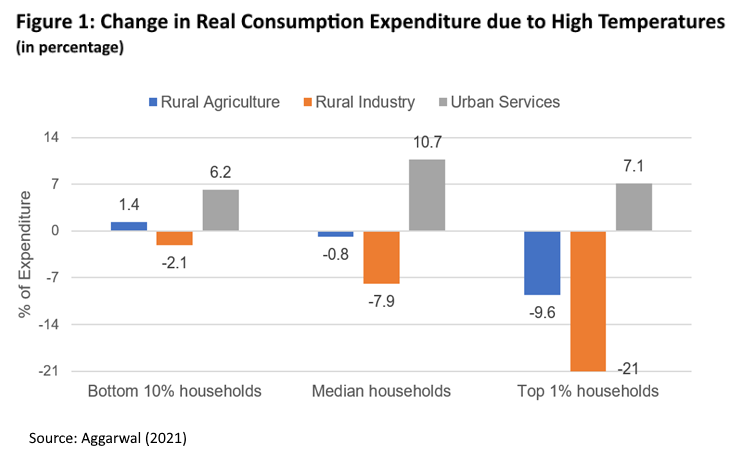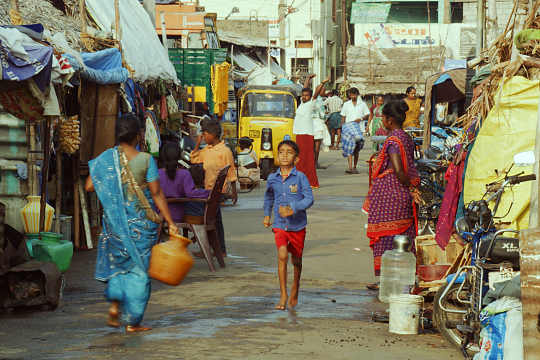High temperatures have unequal impacts on household consumption across India and thus widen socio-economic inequality. To fight this, the country’s climate response must promote mindful consumption among the affluent and equip vulnerable communities with effective tools for survival.
Human economic activities are known to have caused a rise in temperature by over 1°C since the pre-industrial era. The temperature rise, spurred by an increase in greenhouse gas emissions, can have very adverse effects on the economy and society. A high temperature and inadequate rainfall can cause drought, damaging crops and making workers susceptible to heat-related illnesses. Unfavorable weather conditions can also lead to distress migration, particularly from coastal areas that are prone to a rise in sea level.
In a recent study, I evaluated the impact of weather shocks induced by long-term climate change on households’ consumption expenditure, a proxy for the standard of living, in India over the last three decades (Aggarwal 2021). The study mapped household-level data on monthly per capita consumption expenditure from National Sample Survey (NSS) surveys (1987 to 2012) with monthly district-level data on temperature and precipitation from the University of East Anglia’s Climatic Research Unit. The study showed high temperatures have unequal impacts on household consumption across India and raise socio-economic inequality.
Effect on farmers
While farmers have contributed the least to climate change, they bear the brunt of its effect. Delays in the onset of the monsoon and unpredictable levels of rainfall reduce crop yields and limit food supply. Excess rainfall also causes significant crop damage. This leads to a spike in food prices, spurring food inflation.
Crop damage is worse in regions with limited access to irrigation (Khurshid 2022). Where farmers can rely on groundwater aquifers, they are less vulnerable to drought and can adapt to higher temperatures (Taraz 2017). Farmers who supply food in agricultural produce markets may experience a temporary increase in revenue as food prices rise. However, the shortfall in supply reduces the household consumption expenditure of most farmers in the country.
Farmers with better access to technology may switch to drought-resistant crops, as in the Kashmir valley, where many are switching from maize cultivation to growing lavender (Sunder 2021). Others may shift out of agriculture to off-farm work and take up jobs in public works programs like those under the Mahatma Gandhi National Rural Employment Guarantee Act (MGNREGA) (Taraz 2023). Seasonal demand-driven work programs provide a cushion to those who lose income because of a bad harvest.
For richer landowners, agriculture may become unprofitable over time due to unpredictable weather conditions. The value of agricultural land would then decline, affecting rich farmers. India has lost 70 million hectares of cropped area since 2015, mainly due to extreme rainfall events (Gupta 2022).
Heat stress
Daily wage earners and workers in the informal sector suffer heat stress because of high temperatures. This can lead to illness and a loss in workdays, particularly in factories and the construction sector. Output in the manufacturing sector can thus decline.
Having air conditioning in factories can mitigate heat stress to workers and cool machines, preventing sharp falls in industrial output (Somanathan et al. 2021). The use of air conditioning in commercial buildings and offices prevents heat stress to white-collar workers in the services sector. High temperatures can boost the energy demand in residential and commercial buildings.
The results of the study corroborate these effects (Aggarwal 2021). High temperatures, in relation to long-run averages, generate consumption losses for households dependent on agriculture or those engaged in the informal sector, particularly in rural areas. Households with members employed in the services sector exhibit an increase in energy demand and an overall increase in consumption expenditure.
Effects are unequal across the population. The top 1% of rural agricultural households displays a 10% reduction in monthly consumption expenditure, while the top 1% of households employed in manufacturing or construction in rural areas experience a 21% drop in it (Figure 1). On the other hand, the top 1% of people employed in the services sector in urban areas experience a 7% increase in monthly consumption expenditure, primarily because of a rise in energy demand. Therefore, climate change-induced temperature rise leads to an increase in consumption inequality across the Indian population.

Climate adaptation
My estimates suggest close to 70% of the Indian population has experienced the adverse effects of climate change over the past three decades. Government-led social protection programs are crucial to prevent declines in consumption and social welfare. Temporary demand-driven work programs can provide guaranteed incomes in rural areas while a targeted public distribution system can ensure the supply of foodgrains to households below the poverty line. Adaptation measures, particularly in agriculture, are needed to prevent susceptibility to the monsoon and to provide farmers with information on local weather conditions.
The increase in energy demand by households in urban areas, in part because of the rising use of air conditioning and cooling devices, will further increase greenhouse gas emissions and exacerbate the temperature rise. Rao et al. (2019) have estimated the minimum energy requirements to achieve decent living standards in India and meet the United Nation’s Sustainable Development Goals (SDGs). They find that the use of air conditioning requires five times more energy than that needed to maintain adequate thermal comfort in Indian homes and meet the SDGs by 2030.
As climate change mitigation picks up pace, the question of allocating carbon budgets to individuals occupies center stage. Recent studies show that the rise in greenhouse gas emissions in India is driven largely by the 10% of richest individuals, especially through their demand for electricity and private transport (Chancel 2022). These sectors would need to be taxed to curb excess energy consumption.
Providing electricity sourced largely from renewable energy, and reducing the share of coal in the electricity generation mix, will reduce greenhouse gas emissions, even as the demand for energy rises in the coming decades. Expanding the use of public transport by providing last-mile connectivity, developing mass transit systems, and improving the quality of existing infrastructure will increase the use of public transportation, reducing the need for private vehicles.
Moderating excess energy use by rich individuals and ensuring access to clean energy access to poorer households will ensure India’s climate change strategy is more equitably managed and lead to sustainable growth in the coming decades.
Originally published in Ideas for India. Published with permission.
Raavi Aggarwal is a Visiting Assistant Professor at the Centre for Research on the Economics of Climate, Food, Energy and Environment Indian Statistical Institute, Delhi.
